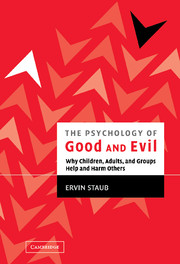Book contents
- Frontmatter
- Contents
- Preface
- Acknowledgments
- PART I INTRODUCTION AND CORE CONCEPTS
- PART II THE ROOTS OF HELPING OTHER PEOPLE IN NEED IN CONTRAST TO PASSIVITY
- PART III HOW CHILDREN BECOME CARING AND HELPFUL RATHER THAN HOSTILE AND AGGRESSIVE
- PART IV THE ORIGINS OF GENOCIDE, MASS KILLING, AND OTHER COLLECTIVE VIOLENCE
- PART V THE AFTERMATH OF MASS VIOLENCE: TRAUMA, HEALING, PREVENTION, AND RECONCILIATION
- 33 Preventing Group Violence
- 34 Kosovo: The Need for Flexible Bystander Response
- 35 The Effects of Violence on Groups and Their Members
- 36 Healing, Reconciliation, and Forgiving after Genocide and Other Collective Violence
- 37 Healing, Forgiveness, and Reconciliation in Rwanda: Project Summary and Outcome, with Addendum on Other Projects
- 38 Further Avenues to Prevention
- 39 Commentary: Human Destructiveness and the Refugee Experience
- 40 A Vision of Holocaust Education in Holocaust Centers and Schools
- 41 Out of Hiding
- 42 Review of Legacy of Silence: Encounters with Children of the Third Reich
- 43 What Can We Learn from This Tragedy? A Reaction Days after September 11, 2001
- PART VI CREATING CARING, MORALLY INCLUSIVE, PEACEFUL SOCIETIES
- Appendix: What Are Your Values and Goals?
- Index
- References
42 - Review of Legacy of Silence: Encounters with Children of the Third Reich
Published online by Cambridge University Press: 07 May 2010
- Frontmatter
- Contents
- Preface
- Acknowledgments
- PART I INTRODUCTION AND CORE CONCEPTS
- PART II THE ROOTS OF HELPING OTHER PEOPLE IN NEED IN CONTRAST TO PASSIVITY
- PART III HOW CHILDREN BECOME CARING AND HELPFUL RATHER THAN HOSTILE AND AGGRESSIVE
- PART IV THE ORIGINS OF GENOCIDE, MASS KILLING, AND OTHER COLLECTIVE VIOLENCE
- PART V THE AFTERMATH OF MASS VIOLENCE: TRAUMA, HEALING, PREVENTION, AND RECONCILIATION
- 33 Preventing Group Violence
- 34 Kosovo: The Need for Flexible Bystander Response
- 35 The Effects of Violence on Groups and Their Members
- 36 Healing, Reconciliation, and Forgiving after Genocide and Other Collective Violence
- 37 Healing, Forgiveness, and Reconciliation in Rwanda: Project Summary and Outcome, with Addendum on Other Projects
- 38 Further Avenues to Prevention
- 39 Commentary: Human Destructiveness and the Refugee Experience
- 40 A Vision of Holocaust Education in Holocaust Centers and Schools
- 41 Out of Hiding
- 42 Review of Legacy of Silence: Encounters with Children of the Third Reich
- 43 What Can We Learn from This Tragedy? A Reaction Days after September 11, 2001
- PART VI CREATING CARING, MORALLY INCLUSIVE, PEACEFUL SOCIETIES
- Appendix: What Are Your Values and Goals?
- Index
- References
Summary
Book Review
Legacy of Silence: Encounters with Children of the Third Reich. By Dan Bar-On. Cambridge: Harvard University Press, 1989.
In the last two decades increasing attention has focused on how human beings deal with and make sense of their victimization and trauma. After long neglect of their experience and fate, attention has focused on how survivors of the horrors of the Holocaust have been affected by and deal with their experiences, and on how children of the survivors have been affected by growing up with their deeply traumatized parents. In this book Dan Bar-On examines how the children of the perpetrators of the Holocaust, the children of Nazis involved in the extermination policy or process, deal with the circumstances their lives handed them.
He made contact with 58 children of perpetrators and interviewed all but nine who refused to see him. There is an introductory and a concluding chapter, and 13 chapters that present individual interviews. The author asks questions and provides brief statements – of his emotional reactions, thoughts, or interpretations – at a few points along the way and at the end of each interview. But he is primarily an unobtrusive although important presence. He provides a frame for the interviewees' stories.
The interviews show the immense struggle of the children of perpetrators to comprehend what happened, to create a tolerable relationship to their dead or still alive perpetrator father, and to build their own identity in the shadow of this heritage.
- Type
- Chapter
- Information
- The Psychology of Good and EvilWhy Children, Adults, and Groups Help and Harm Others, pp. 474 - 478Publisher: Cambridge University PressPrint publication year: 2003



